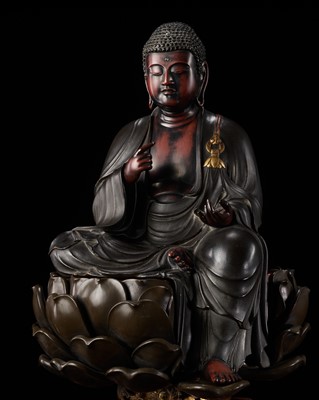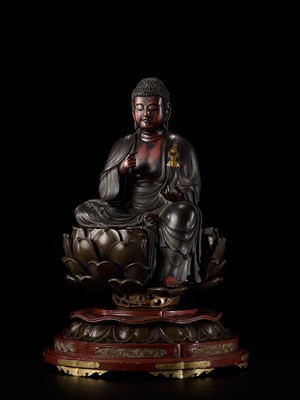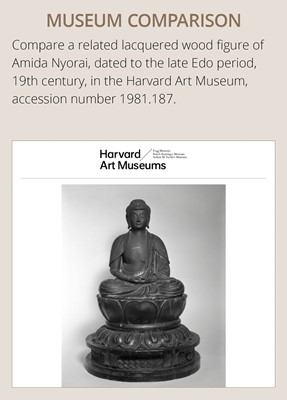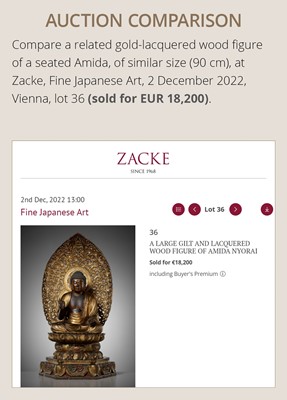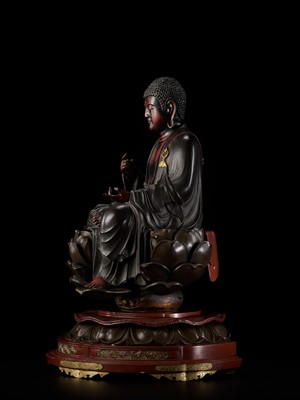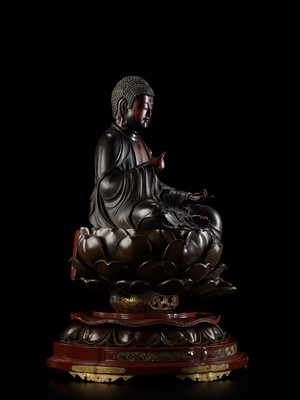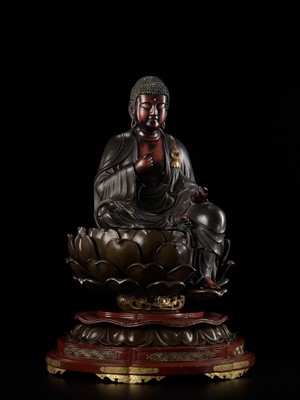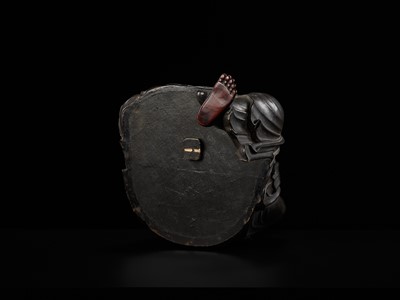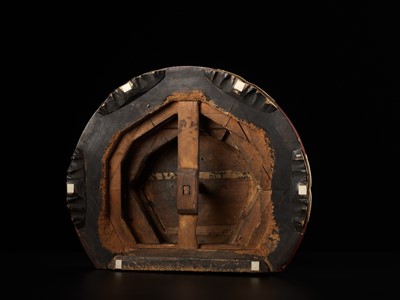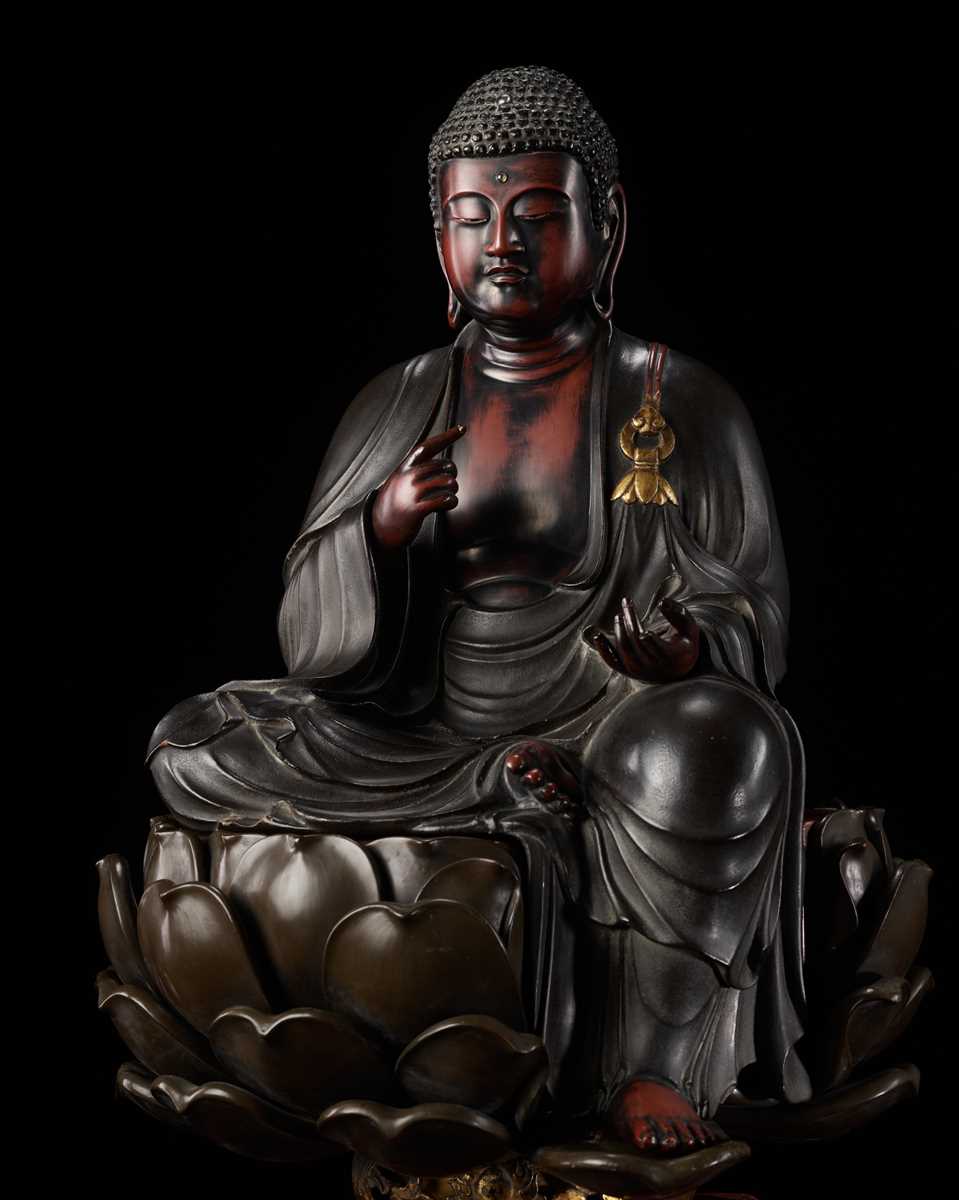1st Dec, 2023 13:00
Fine Japanese Art
49
A LARGE AND IMPRESSIVE LACQUERED WOOD FIGURE OF AMIDA NYORAI, LATE EDO
Sold for €13,000
including Buyer's Premium
Japan, 19th century, late Edo period (1615-1868)
Covered in black, red, and olive-brown lacquer seated in royal ease (lalitasana) on a lotus pedestal supported by a compressed orb above a tiered pedestal with lotus petals, diapered ground, and chased gilt-metal supports, Amida resting his left leg on a finely formed lotus petal bending beneath his foot. Assembled in yosegi-zukuri and finely carved, Amida is holding his left hand semui-in (abhaya mudra), the other lowered on his lap, wearing flowing robes opening at the chest, cascading in voluminous folds, and held by a gilt-lacquer clasp decorated with lotus petals and nyoi scepter heads. His face set with a serene expression with downcast eyes and rock crystal byakugo (urna), his hair arranged in tight curls over the domed ushnisha with a further rock crystal inlay.
HEIGHT 55 cm (figure), 78 cm (incl. stand)
Condition: Good condition with minor wear, small nicks, light scratches, and a few repairs to the hands and pedestal. Overall presenting beautifully.
Provenance: From a noted French private collection.
The sculpture represents Amitabha, known in Japanese as Amida Nyorai, or the Buddha of Limitless Light. Amitabha reigns over the Western Pure Land, a paradise to which anyone is welcomed if they faithfully and sincerely incant his name. This place of salvation became central to the Jodo [lit. Pure Land] sect of Buddhism. Propounded in 1175 by the monk Honen, the accessibility of such tenets of redemption allowed this form of Buddhism to proliferate across the nation and feudal classes of Japan. Often depicted with an elaborate mandala, the boat-shaped halo is said to remind his followers that he serves as a guide for them to cross the ocean of suffering which contaminates the living.
Yosegi-zukuri, or joined wood-block construction, is a sculpting method in which several rectangular blocks of wood are individually selected and carved into shapes. Yosegi-zukuri, together with ichiboku-zukuri (single block construction), are the two main techniques associated with wood sculpture in Japan. There were several advantages of a sculpture made from multiple blocks of wood. It was much lighter than one carved out of a single block of wood. The technique also helped to minimize the cracking of the wood caused by the outside layer drying faster than the core of the sculpture.
Museum comparison:
Compare a related lacquered wood figure of Amida Nyorai, dated to the late Edo period, 19th century, in the Harvard Art Museum, accession number 1981.187.
Auction comparison:
Compare a related gold-lacquered wood figure of a seated Amida, of similar size (90 cm), at Zacke, Fine Japanese Art, 2 December 2022, Vienna, lot 36 (sold for EUR 18,200).
Japan, 19th century, late Edo period (1615-1868)
Covered in black, red, and olive-brown lacquer seated in royal ease (lalitasana) on a lotus pedestal supported by a compressed orb above a tiered pedestal with lotus petals, diapered ground, and chased gilt-metal supports, Amida resting his left leg on a finely formed lotus petal bending beneath his foot. Assembled in yosegi-zukuri and finely carved, Amida is holding his left hand semui-in (abhaya mudra), the other lowered on his lap, wearing flowing robes opening at the chest, cascading in voluminous folds, and held by a gilt-lacquer clasp decorated with lotus petals and nyoi scepter heads. His face set with a serene expression with downcast eyes and rock crystal byakugo (urna), his hair arranged in tight curls over the domed ushnisha with a further rock crystal inlay.
HEIGHT 55 cm (figure), 78 cm (incl. stand)
Condition: Good condition with minor wear, small nicks, light scratches, and a few repairs to the hands and pedestal. Overall presenting beautifully.
Provenance: From a noted French private collection.
The sculpture represents Amitabha, known in Japanese as Amida Nyorai, or the Buddha of Limitless Light. Amitabha reigns over the Western Pure Land, a paradise to which anyone is welcomed if they faithfully and sincerely incant his name. This place of salvation became central to the Jodo [lit. Pure Land] sect of Buddhism. Propounded in 1175 by the monk Honen, the accessibility of such tenets of redemption allowed this form of Buddhism to proliferate across the nation and feudal classes of Japan. Often depicted with an elaborate mandala, the boat-shaped halo is said to remind his followers that he serves as a guide for them to cross the ocean of suffering which contaminates the living.
Yosegi-zukuri, or joined wood-block construction, is a sculpting method in which several rectangular blocks of wood are individually selected and carved into shapes. Yosegi-zukuri, together with ichiboku-zukuri (single block construction), are the two main techniques associated with wood sculpture in Japan. There were several advantages of a sculpture made from multiple blocks of wood. It was much lighter than one carved out of a single block of wood. The technique also helped to minimize the cracking of the wood caused by the outside layer drying faster than the core of the sculpture.
Museum comparison:
Compare a related lacquered wood figure of Amida Nyorai, dated to the late Edo period, 19th century, in the Harvard Art Museum, accession number 1981.187.
Auction comparison:
Compare a related gold-lacquered wood figure of a seated Amida, of similar size (90 cm), at Zacke, Fine Japanese Art, 2 December 2022, Vienna, lot 36 (sold for EUR 18,200).
Zacke Live Online Bidding
Our online bidding platform makes it easier than ever to bid in our auctions! When you bid through our website, you can take advantage of our premium buyer's terms without incurring any additional online bidding surcharges.
To bid live online, you'll need to create an online account. Once your account is created and your identity is verified, you can register to bid in an auction up to 12 hours before the auction begins.
Intended Spend and Bid Limits
When you register to bid in an online auction, you will need to share your intended maximum spending budget for the auction. We will then review your intended spend and set a bid limit for you. Once you have pre-registered for a live online auction, you can see your intended spend and bid limit by going to 'Account Settings' and clicking on 'Live Bidding Registrations'.
Your bid limit will be the maximum amount you can bid during the auction. Your bid limit is for the hammer price and is not affected by the buyer’s premium and VAT. For example, if you have a bid limit of €1,000 and place two winning bids for €300 and €200, then you will only be able to bid €500 for the rest of the auction. If you try to place a bid that is higher than €500, you will not be able to do so.
Online Absentee and Telephone Bids
You can now leave absentee and telephone bids on our website!
Absentee Bidding
Once you've created an account and your identity is verified, you can leave your absentee bid directly on the lot page. We will contact you when your bids have been confirmed.
Telephone Bidding
Once you've created an account and your identity is verified, you can leave telephone bids online. We will contact you when your bids have been confirmed.
Classic Absentee and Telephone Bidding Form
You can still submit absentee and telephone bids by email or fax if you prefer. Simply fill out the Absentee Bidding/Telephone bidding form and return it to us by email at office@zacke.at or by fax at +43 (1) 532 04 52 20. You can download the PDF from our Upcoming Auctions page.
How-To Guides
How to Create Your Personal Zacke Account
How to Register to Bid on Zacke Live
How to Leave Absentee Bids Online
How to Leave Telephone Bids Online
中文版本的操作指南
创建新账号
注册Zacke Live在线直播竞拍(免平台费)
缺席投标和电话投标
Third-Party Bidding
We partner with best-in-class third-party partners to make it easy for you to bid online in the channel of your choice. Please note that if you bid with one of our third-party online partners, then there will be a live bidding surcharge on top of your final purchase price. You can find all of our fees here. Here's a full list of our third-party partners:
- 51 Bid Live
- EpaiLive
- ArtFoxLive
- Invaluable
- LiveAuctioneers
- the-saleroom
- lot-tissimo
- Drouot
Please note that we place different auctions on different platforms. For example, in general, we only place Chinese art auctions on 51 Bid Live.
Bidding in Person
You must register to bid in person and will be assigned a paddle at the auction. Please contact us at office@zacke.at or +43 (1) 532 04 52 for the latest local health and safety guidelines.
